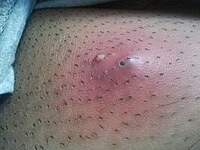
Photo from wikipedia
INTRODUCTION Staphylococcusaureus (S. aureus) is a common germ present in bacterial infections in children. Lately, the rate of methicillin-resistant S. aureus (MRSA) is increasing. OBJECTIVES The main aim of this… Click to show full abstract
INTRODUCTION Staphylococcusaureus (S. aureus) is a common germ present in bacterial infections in children. Lately, the rate of methicillin-resistant S. aureus (MRSA) is increasing. OBJECTIVES The main aim of this study is to know the rate of positive cultures to MRSA in Spanish pediatric emergency departments. The secondary aims are to analyze the risk factors for MRSA isolation (patient origin, history of hospitalization or surgery in the previous 90 days, antibiotherapy in the previous 60 days, presence of comorbidity, invasive devices, prior MRSA isolation) and to analyze the morbidity of these infections. METHODOLOGY Retrospective multicenter study (07/01/2017-06/30/2018) with review of patient histories with isolation of S. aureus in samples of any origin obtained in 8 pediatric emergency departments of the Infectious Diseases Working Group of the Spanish Society of Pediatric Emergencies. RESULTS During this period, S. aureus was detected in 403 patients (average age 75.8±59.2 months; 54.8% male): 28.8% hospital-related infections and 71.2% community-related infections. Overall, MRSA rate was 16.6% (95% CI: 13-20.2%); 18.1% in hospital-related infections and 16.2% in community-related infections (P>.05). The highest rates of MRSA were obtained in skin abscesses (29.3%, 95% CI: 21.8-36.8%), patients not born in Spain (52%; 95% CI: 32-72%) or patients with a previous MRSA infection (90%; 95% CI: 71.4-100%). 167 (41%) patients were admitted, 12 (3%) had complications and 4 (1%) suffered sequels. There were no deaths. CONCLUSIONS The overall MRSA rate was one in six staphylococcal infections. Higher MRSA rates were detected in samples of suppurating skin injuries and in foreign children or in children with a history of previous MRSA infection. In suppurative skin lesions, early drainage is essential and the change to an antibiotic with MRSA coverage should be considered if the evolution is inadequate.
Journal Title: Anales de pediatria
Year Published: 2021
Link to full text (if available)
Share on Social Media: Sign Up to like & get
recommendations!